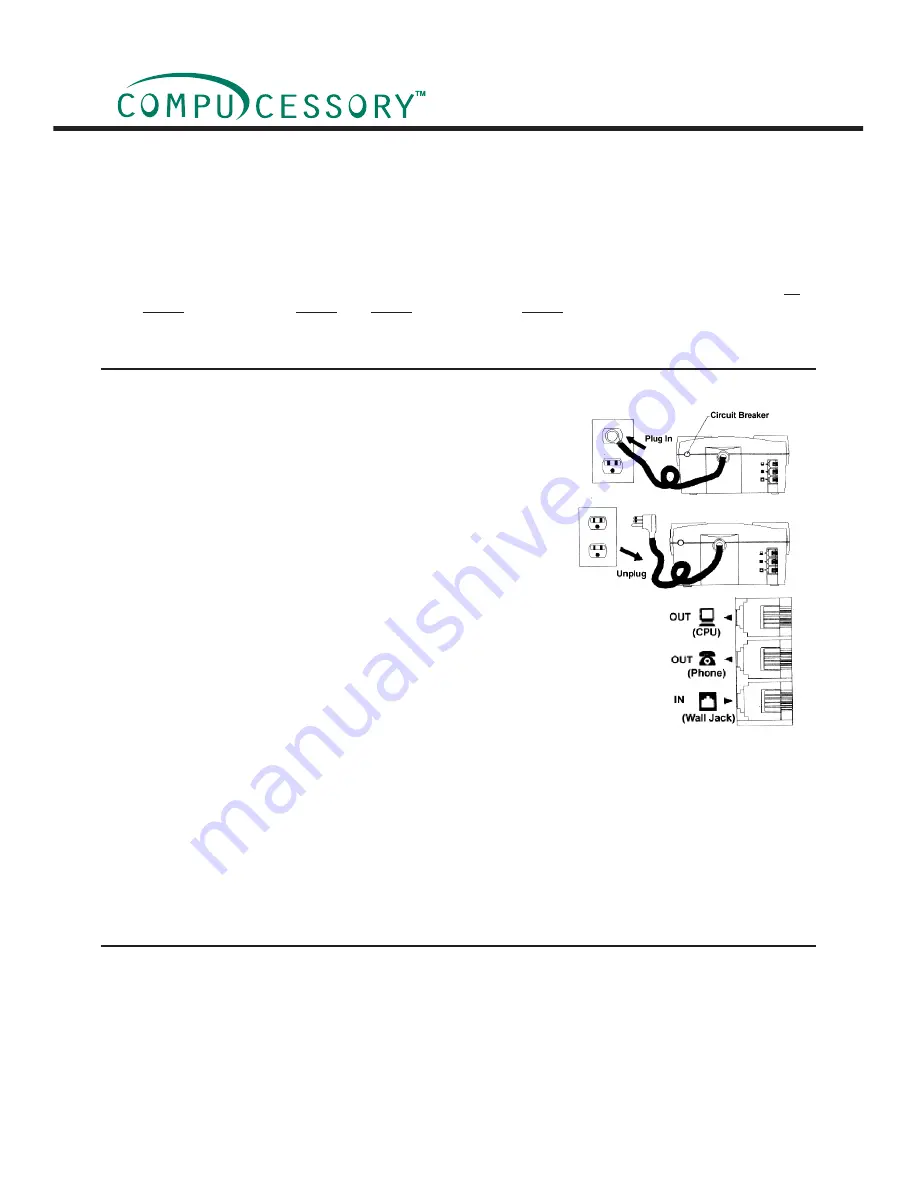
. Make sure that the total Volt-Amp (VA) requirements of your computer, monitor and peripheral equipment does
not exceed 425VA.
2. Insure that the equipment plugged into the three battery power-supplied outlets does not exceed the UPS unit’s
rated capacity(425VA/230W for model # 25654). If rated unit capacities are exceeded, an overload condition may
occur and cause the UPS unit to shut down and the circuit breaker to trip.
3. If the power requirements of your equipment are listed in units other than Volt-Amps (VA), convert Watts (W)
or Amps (A) into VA by doing the calculations below. Note: The below equation only calculates the maximum
amount of VA that the equipment can use, not what is typically used by the equipment at any one time. Users
should expect usage requirements to be approximately 60% of below value to estimate power requirements:
Watts (W) x .82 = VA or Amps (A) x 20 = VA
Add the totals up for all pieces of equipment and multiply this total by .6 to calculate actual requirements.
There are many factors that can effect the amount of power that your computer system will require. The total load
that you will be placing on the battery-powered outlets should not exceed 80% of the unit’s capacity.
HOW TO DETERMINE THE POWER REQUIREMENTS OF YOUR EQUIPMENT
. Your new UPS may be used immediately upon receipt. However,
recharging the battery for at least four hours
is recommended to
insure that the battery’s maximum charge capacity is achieved. Charge
loss may occur during shipping and storage. To recharge the battery,
simply leave the unit plugged into an AC outlet. The unit will charge in
both the on as well as the off position.
2. If you wish to use the software, connect the enclosed serial
interface cable to the serial port on the UPS and an open serial port on
the computer. If you are not going to use the software, you do not need
to connect the cable.
3. With the UPS unit off and unplugged, connect your computer, monitor,
and any externally powered data storage device (Zip drive, Jazz drive,
Tape drive, etc…) into the battery power supplied outlets. Plug your
peripheral equipment (printer, scanner, speakers) into the full-time
surge protection outlets.
DO NOT plug a laser printer, copier, space heater, vacuum
or other large electrical device into the UPS. The power demands of these devices
will overload and possibly damage the unit.
4. To protect a fax, phone or modem, connect a telephone cable from the wall jack outlet to
the in jack of the UPS. Connect a telephone cable from the out jack with the CPU icon
to the modem port on your computer. The out jack with the telephone icon can be used
to protect a telephone or fax machine.
5. Plug the UPS into a 2 pole, 3 wire grounding receptacle (wall outlet). Make sure the wall
branch outlet is protected by a fuse or circuit breaker and does not service equipment
with large electrical demands (e.g. refrigerator, copier, etc…). Avoid using extension cords. If used, the extension
cord must be rated for 5 amps.
6. Depress the power switch to turn the unit on. The power on indicator light will illuminate and the unit will “beep”
once.
7. If an overload is detected, an audible alarm will sound and the unit will emit one long beep. To correct this, turn
the UPS off and unplug at least one piece of equipment from the battery power supplied outlets. Wait 0 seconds.
Make sure the circuit breaker is depressed and then turn the UPS on.
8. Your UPS is equipped with an auto-charge feature. When the UPS is plugged into an AC outlet, the battery will
automatically recharge.
9. To maintain optimal battery charge, leave the UPS plugged into an AC outlet at all times.
0. To store your UPS for an extended period, cover it and store with the battery fully charged. Recharge the battery
every three months to insure battery life.
Hardware Installation Guide
POWERPANEL
™
SOFTWARE
OVERVIEW
PowerPanel™ version 2..4 or greater is designed for use with Windows 95, Windows 98, Windows Me, Windows
NT, Windows 2000, and Windows XP. The latest version can be downloaded from www.cyberpower-eu.com/down-
load.html. It works in conjunction with the UPS to provide full protection of valuable computer systems, applications
and data. In the event of a power failure, PowerPanel™ automatically saves and closes open files under auto-as
-
signed file names or existing files names after a software controlled delay. The computer and UPS are auto-matically
shutdown to conserve battery power. Files with auto-assigned names will be saved under
C:\PCTemp
, where
C
is
the name of your main hard drive.
2



























